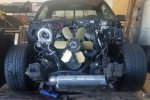You already have the heads off. The motor mount long bolts can be accessed from above. Just don't forget to put the bolts in with the nuts forward or they won't come out again unless the manifolds are removed first.
If the engine is still complete:
Remove the lower heat exchanger which makes it easier to:
Remove the exhaust crossover which has to be off because the trans cooler lines go through it. Easier to take the crossover off than to remove the lines.
Remove the front drive shaft, makes it easier to:
Remove the T-case brace, which the lower trans bolt goes through, and to:
Remove the lower bellhousing / torque converter cover, makes it easier to: (Remove the torque converter to flexplate bolts)
Remove the starter, makes it easier to:
Remove the RH motor through bolt.
Remove the LH motor mount through bolt (made easier by removal of lower heat exchanger and front drive shaft).
The two lower bellhousing bolts on the RH side can be a bitch if the original downpipe brace is still present and attached. The two bolts have studs on them for the brace. They are a bitch. Unless the truck is a low mileage garage queen, I usually don't reinstall the stud/bolts, brace, or the bolt to the downpipe.
I leave as much as possible on the engine for R&R. Makes it quicker and easier.
You have to lift the transmission bellhousing until it touches the top of the tunnel, or you can't slide the engine forward to get it out. The book says to remove the transmission, then remove the engine. I've done it both ways. It's easier to install the trans after the engine is in, and it's easier to remove the engine after the trans is out. I only remove the trans if there is a reason to, such as I'm going to work on both units at the same time.
TLDR, but maybe someone will find something useful


